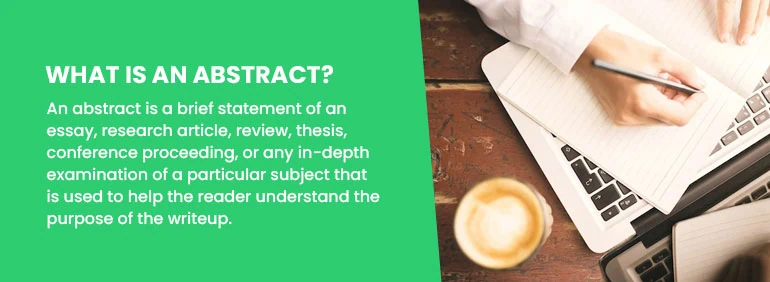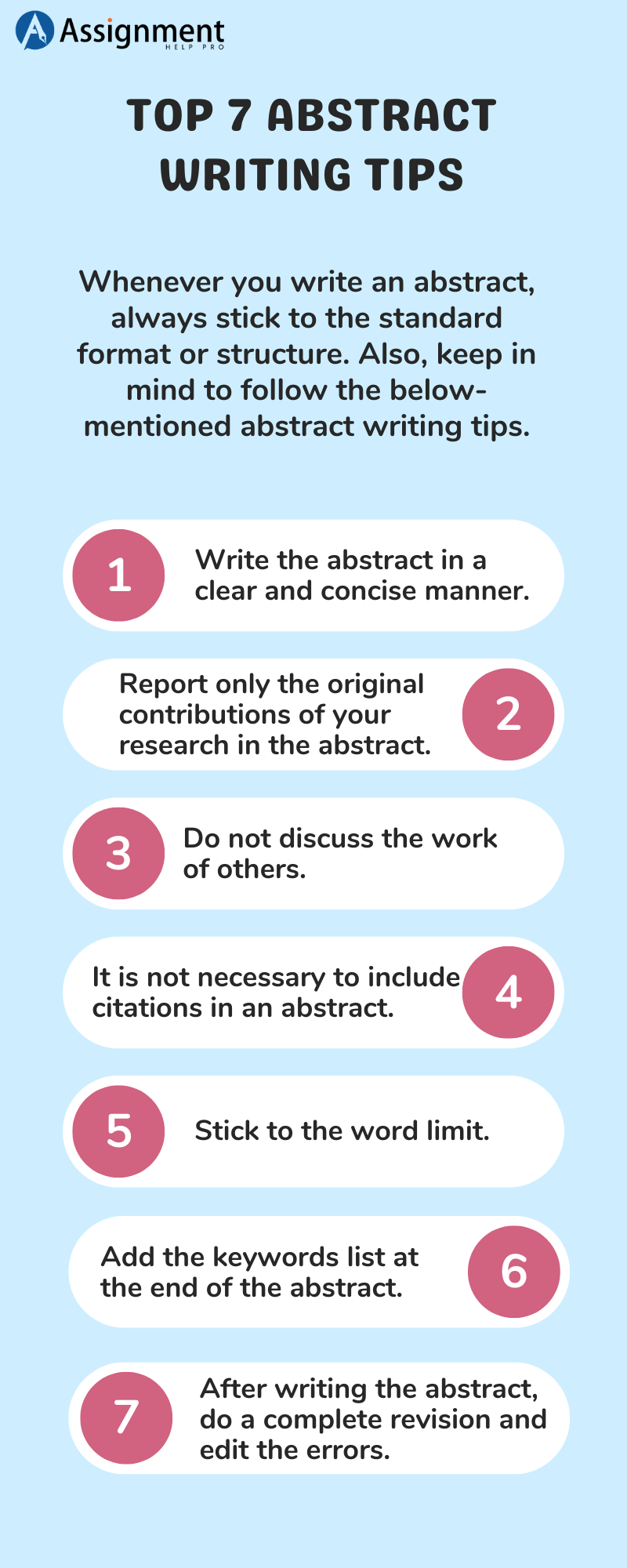In academic research papers, the abstract is one of the important sections that should not be omitted because it will help the readers determine whether the research paper that they are currently reading is what they are searching for. So, the abstract should be written precisely covering major elements of the entire work. As the abstract is an essential part of scholarly work, thesis, and dissertation projects, it is mandatory for all college and graduate students to have knowledge of the different types of abstracts and how to write an abstract effectively. In case, you would like to know in detail about abstract writing, then continue reading this blog. From here, you can learn about the definition of an abstract, its types, and the steps for writing it.
What is an Abstract?

A brief summary of a thesis, dissertation, or research paper is called an abstract. In order to explain to readers what the entire paper is about, it provides a brief explanation of your research’s objectives and outcomes. The contents of your research, as well as its purpose, scope, and results, ought to be included in a compelling abstract.
The abstract is the opening section of the research paper, and it ought to be put after the title page. Since the abstract is a succinct summary of the lengthy work, you can write it after you have fully comprehended its scope.
The abstract should typically be between 150 and 300 words long. In case, you are approached to compose an abstract, check your college or journal’s necessities because occasionally the word length changes. Whenever you write a dissertation, thesis, article, or research paper, you can add an abstract.
Types of Abstract
The abstract is of two types – Descriptive and Informative
Descriptive Abstract
This type of abstract shares the information with a research paper as a short summary of about 100 words or less. It should contain keywords within a paper but should not have the research conclusions and results.
Informative Abstract
This type of abstract shares the information included in the descriptive abstract along with research results and conclusions. Here, you should explain the main arguments with supporting evidence. The length of the informative abstract should not be more than 10% of the entire paper.
Know How to Write an Abstract
Till now we have learned about the basics of abstracts and their types. Next, let us move forward and get to know about abstract writing steps.
Generally, the abstract should be independent and should not contain copied text from the paper. When you write an abstract, remember, it should be concise and the readers should be able to understand what is there inside the paper without reading it completely. So, keep that in mind and follow the below-mentioned steps before you start writing an abstract.
- Write the entire research paper. If you write the whole paper first, then you will get a clear idea of what to summarize in your abstract.
- Understand the abstract writing requirements. University of Journal publications usually follow certain abstract writing guidelines. So, go through that and learn about the length and format of the abstract.
- Know about your audience. You are writing the abstract only for your readers to understand the context of your paper quickly. So, identify your readers and use the language appropriately.
- Determine the abstract type. If you are asked to write an abstract in a specified type, then no issues, you can follow that style. If not, you can prefer either an informative or descriptive type depending on your topic. Generally, informative abstracts are used predominantly for longer research papers and technical research works while the descriptive type is used for shorter research papers.
- Sketch an Outline. After that, you determine the abstract type, read your entire research paper completely and make a note of the important keywords, key terms, and argument or research topic. With the outline, you can develop a well-structured abstract.
Standard Structure and Format of an Abstract
Now, you will have gained an idea about the steps you need to follow before you start writing an abstract. After completing all the steps, you can go ahead and start writing an abstract by including the following sections.
Introduction
Begin your abstract by defining the research purpose. In this introductory section, you need to explain the research question you aim to answer in your paper. Here, it is not necessary to give detailed background information. But, if needed, you can include a brief context relevant to your topic.
When you write an aim of the paper, always use present or past tense but not future tense. To describe your research purpose, it is advisable to use verbs like evaluate, analyze, test, or investigate.
Methods
After defining the objective of your paper, mention the list of research methods you have used to answer your research question. In this section, be straightforward and explain the overall procedures and the approach you have used in one or two sentences. Explain the methodology in the past simple tense.
Results
Next to methods, mention the research results. If your research is long and complex, you might be having a lot of results. In that case, you need not include the entire results, just highlight only the important findings that will be helpful for the readers to understand the conclusion of your research question.
Conclusion
Finally, after discussing all the research methods and results, next jump to the conclusion. In this section, you need to mention the answer to your research topic. By reading your conclusion, the readers should be able to understand the central idea that your research has argued or proved. Here, you can also include recommendations or suggestions for future research. Always write your conclusion in the simple present tense.

Abstract Writing Tips
Whenever you write an abstract, always stick to the standard format or structure. Also, keep in mind to follow the below-mentioned abstract writing tips.
- Make sure the abstract is written clearly and concisely.
- In the abstract, only describe your research’s original contributions.
- Don’t talk about other people’s work.
- It is not necessary to include citations in an abstract.
- Maintain the word count.
- Add the keyword list at the bottom of the abstract.
- Completely revise the abstract after writing it and correct if there are any errors.
Conclusion
Writing an abstract is not so tough. Simply, follow the guidelines mentioned in this blog post and craft a well-structured and effective abstract in accordance with your university guidelines. But, while you prepare an abstract, make sure to address your readers in a way that is easy for them to understand about your research. Also, remember that the abstract that you create should define the objectives, methods, results, and conclusion of your research problem within a limited word count.



